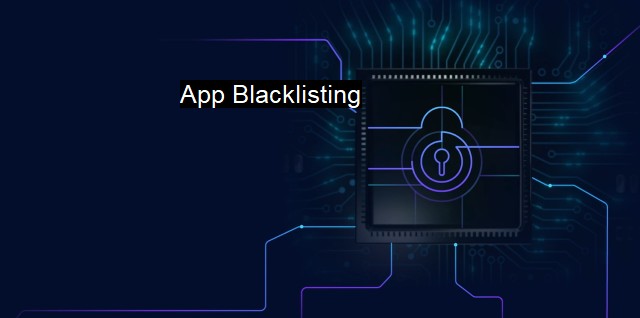What is App Blacklisting?
Defending Against Cyber Threats with App Blacklisting: An In-Depth Look into Comprehensive Antivirus & Cybersecurity Methods
App blacklisting is a prevalent security measure employed primarily as a tool against potential threats directed at mobile and web applications. Understandably, with individuals and enterprises increasingly relying on various apps for everyday activities and managing complex operations, securing these platforms has never been as crucial. Entering the fray in response is the practice of app blacklisting, a preventive tactic designed to control and limit the access of different apps deemed risky or malicious.App blacklisting can essentially be defined as a security approach that involves identifying and categorically refraining potentially harmful or inappropriate applications from being installed or used. The central purpose is to protect both the user's personal data and the overall integrity of the host device, be it a smartphone, tablet, or a computer. This scheme primarily targets rogue applications, particularly malware and adware that can infiltrate the host system, causing massive harm.
The strategy of app blacklisting acts as a barrier, restricting and preventing harmful applications from gaining access to your device's data and operating system. The strategy usually works by maintaining a comprehensive list of apps regulated by criteria such as publisher reputation, behavior, and most notably, their rate and history of known malicious activity. If an app's origins seem suspicious or if it exhibits seemingly harmful behaviour, it is blacklisted, serving as a defence in blocking its usage.
As far as antivirus services go, the feature of app blacklisting is incorporated in nearly all present antivirus solutions. Antivirus software continuously monitors the device for installations and automatically cross-verify them with its central blacklist. If it encounters an app on the blacklist, it alerts the user about the potential cybersecurity threats or blocks the installation.
App blacklisting shouldn't be confused with a consequence-free remedy. Sometimes legitimate apps may exhibit behaviour similar to malicious ones, leading to 'false positives' and inadvertently blacklisting harmless apps. Critical services or tools might be blocked, disrupting regular operations.
While app blacklisting and antivirus mechanisms do not entirely eliminate cyber threats, they significantly decrease the vulnerabilities by restricting known harmful apps. the eternally evolving landscape of cyber threats induces change, pushing cybersecurity professionals to improve their approaches continually. To this extent, app blacklisting has seen some criticism, driving a move towards the concept of 'app whitelisting.'
App whitelisting flips the blacklisting method by accepting only approved and verified apps to operate while blocking all else. It is considered more secure since it allows for tighter control over what can be installed and run. Despite being harder to implement and needing more maintenance, app whitelisting addresses the limitations of blacklisting, particularly concerning the false positives and false negatives problem.
Regardless of discussions on the most effective method, the importance of security measures like app blacklisting is clear in today's interconnected world. Whether for personal use or business operations, ensuring a device's defence against malicious software is critically pertinent. It shields users from a multitude of risks, such as identity theft, loss of critical data or disruption in business continuity.
App blacklisting plays an essential role in cybersecurity and antivirus approach, offering a first line of defence against known threats. It helps regulate the floods of new apps hitting the market while keeping users' data and devices safe. Nonetheless, the continuous evolution of cyber threats requires cybersecurity professionals to be vigilant and adaptive, using blended strategies, including both app blacklisting and whitelisting techniques, to provide sufficient protection against malicious applications.

App Blacklisting FAQs
What is app blacklisting in the context of cybersecurity and antivirus?
App blacklisting is a security measure where certain applications are identified as malicious or untrusted and are added to a list of blacklisted apps. This list is then used by antivirus software to block these apps from running on a device or network, protecting against potential security threats.How does app blacklisting differ from app whitelisting?
App blacklisting and app whitelisting are both security measures used to protect against potential security threats. The main difference is that app blacklisting identifies and blocks known malicious or untrusted apps, while app whitelisting only allows approved and trusted apps to run on a device or network.What are the benefits of using app blacklisting in cybersecurity?
App blacklisting helps to prevent malware and other potential security threats from running on a device or network. By blocking known malicious or untrusted apps, app blacklisting helps to keep sensitive information and data secure. It also helps to prevent unauthorized access to networks and prevents the spread of malware and other security threats.Can app blacklisting be bypassed or circumvented?
While app blacklisting is a useful security measure, it is not foolproof and can be bypassed or circumvented in some cases. Hackers may use techniques such as code obfuscation or app repackaging to evade detection and bypass app blacklisting measures. It is important to use app blacklisting in combination with other security measures and to keep antivirus software up to date to protect against emerging threats.| | A | | | B | | | C | | | D | | | E | | | F | | | G | | | H | | | I | | | J | | | K | | | L | | | M | |
| | N | | | O | | | P | | | Q | | | R | | | S | | | T | | | U | | | V | | | W | | | X | | | Y | | | Z | |
| | 1 | | | 2 | | | 3 | | | 4 | | | 7 | | | 8 | | |||||||